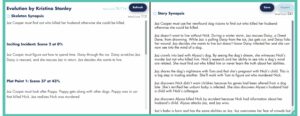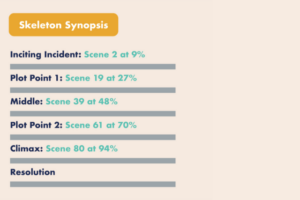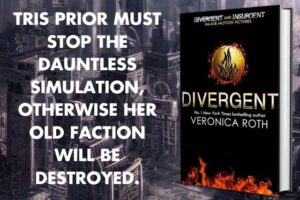
The phrase “write a book synopsis” used to give me the heebie-jeebies.
I’d rather sit through a root canal than attempt to shrink a complex, multi-layered novel into a one-page summary.
It felt like trying to stuff an elephant into your hand luggage.
Impossible, right? And it wasn’t just me. Chat with any author and you’ll find we’d rather face the empty page of a new novel than condense our just-finished masterpiece into a few hundred words.
Take a free trial of Fictionary today and take your story to the next level.
But here’s the kicker…
Despite the mental mountain I had to climb, I knew writing a synopsis was non-negotiable. Every agent, every publisher, heck, even beta readers wanted a snapshot of the story. And who could blame them?
The synopsis is a vital tool for giving a bird’s-eye view of your narrative, setting, characters and the plot twists and turns.
Then, a writer friend recommended Fictionary to me.
Talk about a game-changer. It was like somebody switched on a light in a dark room.
Fictionary made creating a synopsis feel less like a trip to the dentist and more like a strategy game. And guess what? I found out I kinda enjoy strategy games. Writing a synopsis, I discovered, is all about uncovering the skeleton of your story and then building upon it. Stick around, and I’ll show you how it’s done, Fictionary style.
Take a free trial of Fictionary today and take your story to the next level.
What Is a Synopsis of a Book?
You know that feeling when someone asks you, “What’s your book about?” and suddenly your mind goes blank?
Yeah, we’ve all been there. A synopsis is the answer to that all-too-common question.
So, what exactly is a synopsis of a book? Let’s clear that up. A book synopsis is a condensed version of your entire novel. Think of it as your book on a diet, only keeping the essential nutrients, and trimming away the excess.
It includes your novel’s main events, key plot points, and the character arcs of your protagonist(s) – all wrapped up in a neat, digestible package.
It’s your story’s play-by-play, the entire shebang from “Once upon a time” to “They lived happily ever after.”
But remember, a good synopsis doesn’t just relay your plot in a “this happened, then that happened” kind of way. No, siree. It goes deeper. It also needs to convey the emotional journey of your characters.
Are they falling in love? Wrestling with personal demons? Battling an alien invasion? These need to come out in your synopsis.
A book synopsis is more than just a summary. It’s the heart and soul of your novel, stripped bare and laid out for all to see. It’s not always easy to create, but it is crucial. And with Fictionary, it’s about to get a lot easier.
Stick with me, and you’ll see how.
Why is Writing a Book Synopsis so Difficult?

Okay, hands up if you’ve ever broken out in a cold sweat at the mere thought of writing a book synopsis.
Yep, me too.Condensing your masterpiece into a summary feels like an impossible task. But why is that?
Let’s start with the obvious.
You’ve got an epic story teeming with complex characters, surprising twists, emotional depth, and perhaps even a philosophical debate or two. And now, you’re being asked to shrink that down to a page or two? It feels like trying to stuff a king-size duvet into a matchbox.
It’s tough.
Then, there’s the emotional attachment. Your book is your baby. You’ve nurtured it from a mere idea into a full-grown novel. Cutting it down feels a bit like trimming the wings off a bird. How do you decide what to keep and what to let go?
It’s a real emotional roller coaster, folks.
Finally, a good synopsis needs to strike a delicate balance. It must reveal your plot without making it sound too simplistic, all while maintaining an air of intrigue. It’s like being both a magician and a member of the audience—you’ve got to give away the trick without losing the magic. Quite a paradox, isn’t it?
In short, writing a book synopsis is hard because it requires distillation, detachment, and a dab of deception. But fear not, friends, because there’s a method to the madness, and Fictionary is here to guide the way.
How to Write a Novel Synopsis the Fictionary Way

In my experience, the most effective way to write a synopsis is to break it down scene by scene. And there’s no better resource for understanding novel structure scene by scene than Fictionary.
Fictionary provides you with a skeleton synopsis tool to identify the pivotal scenes in their novel. This makes structuring your synopsis a breeze. Let me walk you through it step-by-step…
How to Structure a Skeleton Book Synopsis

While every novel is unique, most follow a similar story structure containing five to seven pivotal scenes:
- Inciting Incident
- Plot Point 1
- Midpoint
- Plot Point 2
- Climax
- Resolution
Fictionary analyses your manuscript and labels where each of these key scenes happens in your book.
To build your skeleton synopsis:
- Identify which of your book’s scenes align with each plot point using the Fictionary beat sheet
- For each scene, answer these three questions:
- Who is the POV character?
- What is their goal?
- What’s at stake if they fail?
- String the scenes together in chronological order.
Following this simple formula gives you the bare bones synopsis containing all the pivotal plot points. You can then flesh out the skeleton into a polished, thorough synopsis.
Take a free trial of Fictionary today and take your story to the next level.
How to Write a Summary of a Book Tips

How Long Is a Synopsis?
Your book synopsis needs to be long enough to convey your story but concise enough to maintain your reader’s attention.
In general, a book synopsis should be between 500 words and 800 words. This translates to a maximum of two pages at a standard font.
If your book synopsis is too long, then an agent may not even pick it up. If it is too short, then they may not understand the brilliance of your story. But if you have the choice, we recommend choosing short and sweet over too long.
How to Structure the Synopsis of a Book?
I get this question a lot: “How on earth do I structure the synopsis of my book?” Well, dear writer, fret not, I’ve got your back!
First off, you’ve got to remember that a synopsis summarises your book’s plot. Now, this doesn’t mean you spill the beans on every tiny detail. Rather, it’s about focusing on the main points and how they connect to form the bigger picture.
Start with an opening that introduces your main character and their world. What’s their situation like when we first meet them? Then, swiftly move on to the inciting incident – the event that sets the story in motion.
Next, sketch out the major conflicts and plot points. Make sure you cover the critical turning points – those game-changing moments that force your protagonist to grow and change. This includes the midpoint, plot points, and of course, the climax.
Then, reveal the resolution. Yes, you’ve got to divulge how the story ends. Remember, a synopsis isn’t a back cover blurb – the purpose is to inform, not to tease.
Finally, keep it concise and stick to the point. Avoid unnecessary subplots, characters, or backstory. Your goal is to give a clear and accurate picture of your story arc. In short: introduce, incite, outline, resolve, and keep it neat! It’s easier said than done, I know, but with a little practice and a sprinkle of Fictionary magic, you’ll master it in no time.
3 Tips for How to Write a Synopsis for a Novel
So, you’re biting your nails and wondering, “What are the secret ingredients to whip up a riveting book synopsis?” Well, put on your author’s hat, because I’m about to spill my top three tips that are sure to take your synopsis game from ‘meh’ to ‘marvellous’!
Story Synopsis Tip 1: Know Your Key Players
Keep your synopsis centred on your main character(s) and their journey. The reader should understand who the protagonist is, what their goals are, and the obstacles they face. This doesn’t mean you have to name every character; stick to those who are crucial to the plot.
Story Synopsis Tip 2: Don’t Shy Away From Spoilers
Unlike a back cover blurb that entices, a synopsis informs. So, reveal how the story ends. Include the resolution of the key conflicts and how the character arcs culminate.
Story Synopsis Tip 3: Keep it concise and engaging
A synopsis is a glimpse into your story, not a blow-by-blow account.
So, resist the temptation to explain every plot twist or character backstory. Stick to the significant events and how they drive the story forward.
In summary, focus on your key characters, embrace spoilers, and practise the art of being concise yet captivating. And remember, writing a great synopsis, like any writing skill, gets better with practice.
Now you know how to write a synopsis, let’s look at an example.
Story Synopsis Example

Here is the scene by scene skeleton synopsis for Veronica Roth’s young adult dystopian novel, Divergent:
Inciting Incident
- POV Character: Beatrice
- Must: Choose a faction at the Choosing Ceremony
- Otherwise: She will become factionless
Why This Scene?
This event kicks off the main action of the novel. Beatrice’s choice will determine the course of her life within the world of the story.
Plot Point 1
- POV Character: Beatrice
- Must: Pass Dauntless initiation.
- Otherwise: She will become factionless
Why This Scene?
Passing initiation is the immediate external goal Beatrice must accomplish after choosing Dauntless. Failure would unravel everything that follows.
Midpoint
- POV Character: Beatrice
- Must: Go through her fear landscape simulation
- Otherwise: She will fail Dauntless initiation
Why This Scene?
The fear simulation is the major turning point in the first half of the book. It’s an important milestone in Beatrice’s progression as an initiate.
Plot Point 2
- POV Character: Beatrice
- Must: Stop the Erudite’s mind control plan
- Otherwise: The Dauntless will massacre Abnegation
Why This Scene?
The plot forces Beatrice to face an impossible choice that will determine the fates of both her family and all Dauntless/Erudite.
Climax
- POV Character: Beatrice
- Must: Release the video exposing the Erudite
- Otherwise: Jeanine will continue manipulating the factions
Why This Scene?
This scene represents the final conflict where Beatrice exploits the Erudite’s lies and prevents further loss of life.
Resolution
- POV Character: Beatrice
- Must: Scatter her mother’s ashes
- Otherwise: She cannot move on from her parents’ deaths
Why This Scene?
The Resolution ties up Beatrice’s emotional character arc regarding her grief over her family.
As you can see, answering those three simple questions about each key scene provides the bare bones plot summary. From here, you would flesh out the details to complete the full synopsis.
Is There a Particular Synopsis Book You Recommend?

If you’re like me, always on the hunt for resources that can help elevate your writing skills, then you’re in luck.
Today, I want to introduce you to a book that’s been a game-changer for me: “Secrets to Editing Success” by Kristina Stanley and Lucy Cooke.
Yes, it’s a bit of self-promotion here, but I genuinely believe this book can be a valuable asset to any writer’s toolkit.
“Secrets to Editing Success” isn’t just another book about writing or editing. It’s a comprehensive guide that demystifies the editing process. The book provides practical advice on how to take your manuscript from good to great.
Kristina and Lucy delve into the nuts and bolts of story editing, sharing tips and tricks gleaned from our years of experience in the field.
One section that I find useful is the one on crafting an interesting book synopsis. The book offers step-by-step guidance on how to structure a synopsis that captures the essence of your story while keeping it concise and engaging.
It breaks down the process into manageable chunks, making it less daunting and more achievable.
Kristina and Lucy packed the book with real-life examples, actionable tips, and practical exercises that help to cement the concepts. It’s like having a personal editing coach in your back pocket.
So, if you’re struggling with writing an interesting synopsis, or any part of the editing process, I highly recommend “Secrets to Editing Success”. It might just be the tool you need to unlock your editing prowess.
Conclusion: What is a Synopsis of a Book

As we bring this journey to a close, let’s circle back to our initial question.
What is a synopsis of a book?
A synopsis, as we’ve discussed, is a concise, interesting summary of your book’s plot. It’s like the appetiser agents, publishers, and readers. It teases them with the promise of an entrancing narrative feast to come.
Creating a book synopsis may seem like a Herculean task.
Trust me, I’ve been there. As a writer, you’ve spent months, possibly years, on your book. And now, you’re asked to shrink this vast, vibrant universe into a one-to-two-page summary. It’s like trying to pack a cruise ship into a toy boat.
Seems impossible, right?
Well, I’ve got good news: it’s not. Difficult? Absolutely. But impossible? Far from it.
We’ve explored why writing a book synopsis is so challenging. We’ve also offered practical advice on how to navigate these challenges the Fictionary way. And don’t forget the concept of a skeleton synopsis. A tool to help you identify and summarise the crucial scenes and moments in your narrative.
Remember, the goal of a synopsis isn’t to encapsulate every detail of your story/
Oh no.
It’s there to give the reader a taste of your plot, characters, and writing style. It’s about capturing the essence of your story and presenting it so it leaves the reader yearning for more.
I would urge you to think of the book synopsis not as an ordeal but as an opportunity.
An opportunity to take a step back, to view your story from a bird’s-eye perspective, and to identify and highlight the aspects that make it truly unique. And as you do, remember that, like any skill, synopsis writing improves with practise.
Keep honing your craft, and who knows, you might just come to enjoy the book synopsis process. And, if you sign up for your 7 day free trial of the Fictionary Software, you’ll have your synopsis done in no time.
Take a free trial of Fictionary today and take your story to the next level.


